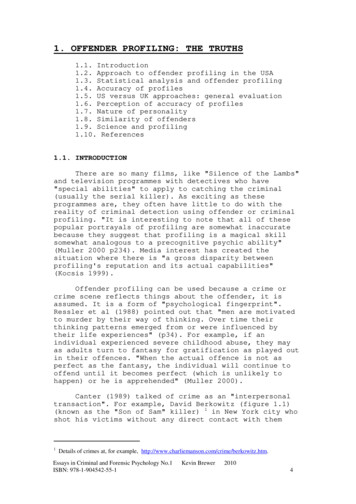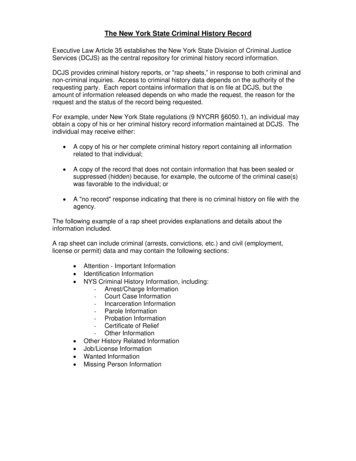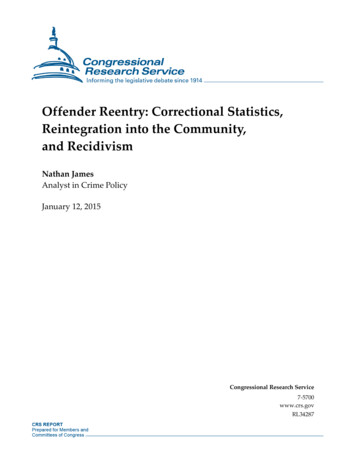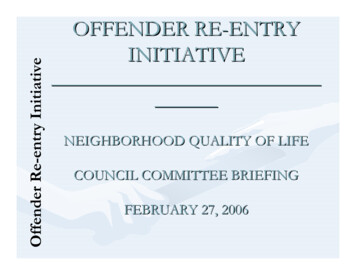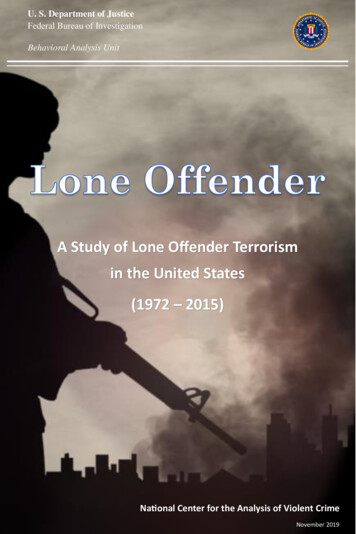
Transcription
U. S. Department of JusticeFederal Bureau of InvestigationBehavioral Analysis UnitA Study of Lone Offender Terrorismin the United States(1972 – 2015)National Center for the Analysis of Violent Crime1November 2019
Message from FBI Director Wray:As we’ve all witnessed, the threats we face from terrorism and targetedviolence are rapidly evolving. We’ve seen a steady increase in the number ofattacks and the array of attack methodologies, targets, and underlyingmotivations driving the attackers. The FBI is committed to using allappropriate tools and resources to prevent these acts from happening. Wework side-by-side with our federal, state, local, and tribal law enforcementpartners to address and mitigate threats of terrorism and targeted violence.These efforts are led largely by our formal task forces, such as JointTerrorism Task Forces and Violent Crime Task Forces, and also through lessformal, but equally important, liaison relationships between the FBI and lawenforcement professionals at all levels of government.But prevention is more than just a law enforcement effort. Law enforcementis working diligently to improve its collaboration and coordination with othergovernment entities, such as community mental health, social services,probation and parole, and educators, as well as private sector partners andstakeholders, to share information and ensure all entities are workingtogether to help manage and mitigate threats.All citizens have a critical role in prevention. Prevention efforts are greatlyenhanced by the early recognition and reporting of suspicious behaviors bythose individuals around a person of concern, such as family members, peers,and community members. Bystanders need guidance to recognize concerningbehaviors and overcome natural resistance to reporting. Just as important asearly recognition by bystanders is the need to have well-trained, skilled, andcompetent receivers of that reporting – individuals who can assess potentialthreats and share information with other stakeholders so that they cangather additional information, further assess the threat, and take action tomitigate that threat.One method for coordinating these often complicated responsibilities is theuse of multi-disciplinary threat assessment and management teams. Thecore concept of these teams brings stakeholders and subject matter expertstogether to accurately and holistically assess threats and to devise effectiveand appropriate threat management strategies.The FBI’s Behavioral Threat Assessment Center (BTAC), established in2010, is a national-level multi-disciplinary and multi-agency threatassessment and management team. The BTAC provides operational support2
to FBI field offices and our law enforcement partners on some of the mostcomplex, concerning, and complicated threat cases related to terrorism andtargeted violence. The BTAC also conducts extensive research on prior actsof terrorism and targeted violence to learn from past events, to enhance andimprove prevention capabilities, and to train the community and otherstakeholders involved in this space. The Lone Offender Terrorism Report(LOTR) is the latest example of this important research.The lessons learned from the LOTR are similar in many ways to past FBIresearch, as well as academic research, on the pre-attack behaviors,stressors, and risk factors exhibited by and experienced by previousattackers. While the attackers in this report were ideologically-motivatedlone offenders, they were rarely completely isolated and alone, and theytraveled down the same observable and discernable pathways to violence asother attackers. The lessons learned in this report reinforce the principlethat, like other acts of targeted violence, lone offender terrorism may bepreventable through early recognition and reporting of concerning behavior.This research report is unique from other research on this topic because ofthe richness and quality of the underlying data used to conduct the research(e.g., case files and other law enforcement records). In addition, the FBI,through the BTAC’s daily work in providing operational support on threatcases, is well positioned to analyze the findings through an operational lensand to make observations from the data, which can be used by other threatassessment professionals. With this focus, the authors of this report haveattempted to look beyond the data to identify and articulate substantivesuggestions and considerations for how readers might apply the lessonslearned to enhance our collective prevention efforts.Christopher A. WrayDirectorFederal Bureau of Investigation3
National Center For The Analysis of Violent CrimeFederal Bureau of InvestigationBehavioral Analysis UnitBehavioral Threat Assessment CenterAbout the Author:4
About the Author:The Federal Bureau of Investigation’s Behavioral ThreatAssessment Center (BTAC) is a national-level, multi-agency, multidisciplinary Task Force focused on the prevention of terrorism andtargeted violence through the application of behaviorally-basedoperational support, training and research. In this unique capacity,the BTAC provides investigative and operational support for the FBI’smost complex, concerning, and complicated international and domesticterrorism investigations. In addition, the BTAC provides threatassessment and threat management support to federal, state, local,tribal and campus law enforcement partners, as well as communitystakeholders, working diligently across the United States on targetedviolence prevention. Significant lines of effort on targeted violenceprevention include persons/adults of concern, potential activeshooters, school shootings/threats, stalking and workplace violence.Primary Authors:Lauren Richards, M.A.,Oak Ridge Institute for Science and Education Research FellowPeter Molinaro, Ph.D.,University of MichiganJohn Wyman, Supervisory Special Agent-Unit Chief,Behavioral Analysis Unit, Federal Bureau of InvestigationSarah Craun, Ph.D., Research Coordinator,Behavioral Analysis Unit, Federal Bureau of Investigation5
National Center for the Analysis ofViolent Crime:The National Center for the Analysis of Violent Crime (NCAVC)coexists with the Federal Bureau of Investigation’s (FBI) BehavioralAnalysis Unit (BAU) and are both components of the FBI’s CriticalIncident Response Group (CIRG) located at the FBI Academy inQuantico, Virginia. The primary mission of NCAVC/BAU is to providebehavioral-based operational support to federal, state, local, andinternational law enforcement agencies involved in the investigationof unusual or repetitive violent crimes, communicated threats,terrorism, and other matters of interest to law enforcement.The NCAVC/BAU is comprised of several units, each specializing inmatters such as threat assessment, crimes against adults, crimesagainst children, cyber and counterintelligence, violent criminalapprehension program, and research.NCAVC/BAU staff members conduct detailed analysis of crimes frombehavioral, forensic, and investigative perspectives. This analysisprocess provides law enforcement agencies with a betterunderstanding of offender motivations and behaviors. The analysis isa tool that provides investigators with descriptive and behavioralcharacteristics of the most probable offender and advice regardinginvestigative techniques to help identify the offender.The NCAVC/BAU also conducts research from a law enforcementperspective. NCAVC/BAU research is designed to gain insight intocriminal thought processes, motivations, and behaviors. Researchfindings are refined into innovative, investigative techniques thatimprove law enforcement’s effectiveness against violent criminals andare shared with law enforcement and other disciplines throughpublications, presentations, and training.6
AcknowledgmentsThe authors would like to acknowledge the efforts of our state andlocal law enforcement partners and BAU Coordinators for the timeand effort that was taken to collect and provide case information. Theauthors would also like to thank the many researchers and BAUmembers, both former and current, who supported this study,including retired Unit Chief (UC) Shawn VanSlyke, Dr. Robert Fein,Bryan Vossekuil, Supervisory Special Agent (SSA) Amanda Moran,Intelligence Analyst (IA) Courtney Brawley, SSA Joseph Bertoldi, IAAndrea Fancher, SSA Stephanie Yanta, Emma Waldner, AlexaLambros, Staff Operations Specialist Jennifer Flynn, Dr. Paul Gill,retired SSA Andre Simons, SSA Terri Patterson, SSA Karie Gibson,SSA Kevin Hughey, and IA Karen McCaulley.7
IntroductionOperationally defining the lone offender terrorist is challenging, as thenature of terrorism is both highly political and contextuallydependent. Over the years, there has been disagreement over theclassification of violent acts under the label of “terrorism.” While anargument can be made that the infliction of fear upon a targeted groupor the public is sufficient to classify an act as terrorism, the FBIdefinition of terrorism requires a purported motivation that goesbeyond exclusively personal motivations and attempts to influencechange in furtherance of extremist ideologies of a social, political,religious, racial or environmental nature. The focus of the currentstudy examined offenders who carried out their attacks independent ofany direction from a terrorist group or organization.In 2009, the FBI’s Critical Incident Response Group (CIRG)Behavioral Analysis Unit (BAU) published a guide titled ThreatManagement for the Lone Offender, which offered preliminaryoperational guidance for managing potential threats based upon caseobservations. The guide introduced the early conceptualization of thisLone Offender Terrorism Study and began to compile data from aninitial sample of twenty-one offenders. The initial coding protocol wasmodeled after the first operational exploration of 83 known attacksand approaches against public officials in the US from 1949 to 1996. 1The current study was built upon these foundations, compilinginformation from federal and state investigative case files, increasingthe sample size from the initial sample size of 21 to 52 cases, andrevising and expanding the existing coding protocol.Lone offender terrorism continues to pose a threat as violentideological groups and terrorist organizations place emphasis oninspiring lone offender-style attacks. Additionally, individuals whoview violence as an accessible and justified method for advancing theirown ideological goals can independently mobilize toward violentaction. While attacks directly coordinated by terrorist organizationsare generally more lethal globally, the United States departs from thistrend: lone offender attacks in the United States are more deadly,possibly due to strong U.S. counterterrorism capacity for disruptingFein, R. & Vossekuil, B. (1999). Assassination in the United States: An operational study of recentassassins, attackers, and near lethal approachers. Journal of Forensic Sciences, 44, 321-33.doi:10.1520/JFS14457J; Fein, R. & Vossekuil, B. (1999). Preventing Assassination: Secret ServiceExceptional Case Study Project. JRS.pdf18
attacks from cells and organizations.2 Despite the overall lowincidence rate of terrorism, counterterrorism and threat assessmentprofessionals are responsible for navigating a diverse and amorphouslandscape of threats from individuals who seek targeted violence as asolution for issues that often blend ideological and personalmotivators.Lone offender terrorism is not unique to a particular religion, culture,or political affiliation. This study on lone offender terrorism attacksincluded offenders who carried out violent attacks in furtherance ofany claimed ideology or cause, as long as the offender was primarilyradicalized within the United States and carried out the attackagainst targets within the United States. There is a certain degree ofoverlap between some ideological movements, and it was notuncommon for offenders in the study to blend elements of multipleideologies.The current report provides an overview of the data, exploring thevarious topics encompassed within the coding protocol, includingbystander observations, offenders’ backgrounds, family and socialnetworks, behavioral characteristics, radicalization, and attackplanning. Predicting lone offender terrorism incidents is not possible,but prior research and operational experience support the conclusionthat acts of targeted violence, including lone offender terrorist attacks,may be preventable through early recognition and reporting ofconcerning behavior. The report aims to inform broader goals ofenhancing bystander education and awareness, as well to aid theprevention efforts of law enforcement and multi-disciplinary threatassessment teams working to counter targeted violence threats everyday. To work toward this objective, the authors examine relevantcontextual factors and analyze the statements and behaviorsoffenders exhibited before carrying out their attacks.Phillips, B. J. (2017). Deadlier in the US? On lone wolves, terrorist groups, and attack lethality. Terrorismand Political Violence, 29(3), 533-549. doi:10.1080/09546553.2015.105492729
MethodTo be included in the current study, offenders must have attempted3or completed an act of lethal violence4 in furtherance of an identifiedsocial, political, or ideological goal. While offenders may haveaffiliated or associated with a terrorist organization/ideologicalmovement or may have received assistance from others at some stageduring the planning or implementation of their attacks, they musthave been both the primary architect and the primary actor in theattack action. The attack must have occurred within the US and theoffender must have radicalized,5 at least primarily, within the UnitedStates.Offenders were identified by reviewing FBI case files and partner lawenforcement records, in addition to searching academic literature,open source media, and the National Consortium for the Study ofTerrorism and Responses to Terrorism (START) Global TerrorismDatabase (GTD).6 Approximately 240 cases were initially identified aspotentially meeting inclusion criteria. Upon reviewing the elements ofeach case, 93 cases ultimately met all inclusion criteria, but 41 caseswere excluded due to either a lack of sufficient information7 or thepresence of pending adjudications or ongoing investigations. Fifty-twocases were coded for use in the study analysis, comprising a sample oflone offender terrorism cases from 1972 to 2015.8Using a 244-question protocol, researchers double-coded9 cases usinginformation obtained primarily from closed investigative files andsupplemented by open source information. Planning and attackrelated variables were coded as they related to the offenders’ indexattack, meaning the first offense that met all of the inclusionAn attempt was included if the offender, in an effort to complete their attack goal, completed a substantiveovert action that could have resulted in fatalities if not for intervention or happenstance.4 “Lethal violence,” as used in this study, specifically referred to acts of violence that were intended to killpeople.5 The FBI defines radicalization as the process by which individuals come to believe that engagement in orfacilitation of non-state violence to achieve social and political change is necessary and justified.6 National Consortium for the Study of Terrorism and Responses to Terrorism (START). (2015). GlobalTerrorism Database [Data file]. Retrieved from https://www.start.umd.edu/gtd7 Cases were excluded if there was not enough information to code at least 60 percent of the coding protocolvariables as present or absent.8 The data reported should not be used to make conclusions regarding trends over time.9 To double-code cases, two research team members independently coded case files using the researchprotocol. The responses from each coder were then compared and any differences were discussed in orderto reach agreement. If agreement could not be reached, differences were reconciled by a third team member.310
requirements detailed above.10 Researchers coded for the presence orabsence of behaviors only when objective case material indicated suchevidence – otherwise, the variable of interest was coded as“unknown/unclear.” Therefore, the data presented in this report areconservative estimates, and the actual rate of occurrence of certainbehaviors and characteristics may be higher than what is reported.The current report has removed all identifying offender information toallow for the widest dissemination possible.Fourteen offenders engaged in additional acts of terrorism. Preliminary data was recorded for thoseadditional acts as part of a Serial Addendum, which was attached to the main coding protocol. The results ofthe Serial Addendum are discussed briefly in this report. Unless otherwise specified, any mention ofoffenders’ attacks throughout the report refers to offenders’ index attacks.1011
Part One: The OffendersDemographicsThe 52 offenders in the study varied widely in characteristics such asage, race, relationship status, and educational background.Consistent with conclusions reached by both academic andgovernment researchers studying targeted violence, the study foundno evidence to support the existence of any meaningful demographicprofile of a lone offender terrorist.11,12GenderPerhaps the only demographic trend consistently seen in studies oftargeted violence is the overwhelming representation of maleperpetrators. Although women can and have engaged in acts oftargeted violence, all 52 offenders in the lone offender terrorism studysample were men.13AgeThe youngest offender was 15 years old and the oldest was 88, withthe distribution of ages displayed in Figure 1.14 The average age atthe time of the attack was 37.7 years old. Radical Islamic violentextremists, who averaged 26.3 years of age at the time of their attack,were significantly younger than the other ideological groups(p 0.05).1511Silver,J., Simons, A., & Craun, S. (2018). A study of the pre-attack behaviors of active shooters in theUnited States between 2000–2013. Federal Bureau of Investigation, U.S. Department of Justice, Washington,D.C. 20535.12Gill, P. (2015). Lone-actor terrorists: A behavioural analysis. Routledge.13 The few female lone offenders identified in the collection phase of the study were not included in the currentdata set due to either a lack of file information or pending investigations/adjudications.14 Except for the youngest offender, all offenders were age 18 or older.15 Age comparisons were run for all ideological groups, but only statistically significant results were included inthe report. It is possible that additional significant differences would be found with the addition of new cases.12
Figure 1Offender Age at Time of Attack*(N 2%0%15-1718-2425-2930-3435-3940-4445-4960 *Does not sum to 100 due to rounding.Offender Age at Time of Attack (N 52)Age Range15-17 years old2%18-24 years old17%25-29 years old12%30-34 years old21%35-39 years old10%40-44 years old15%45-49 years old4%50-54 years old6%55-59 years old6%60 years old and up8%13
Citizenship, Ethnicity, and RaceMost offenders were born in the US (n 47, 90%). Four offenders (8%)were naturalized citizens and one offender (2%) was a legal permanentresident. Most offenders were white/Caucasian (n 34, 65%), while theremaining 18 offenders (35%) were divided among five different racialgroups, as shown in Figure 2.16Figure 2Race/Ethnicity (N iddleEasternBlackBi-racialRace/Ethnicity (N 52)Offender RaceWhite65%Middle ases where race was ambiguous, coders considered any information available about how the offendersself-identified.14
Relationship StatusAs shown in Figure 3, most offenders were not in a relationship ormarried at the time of their attack (n 38, 73%).Figure 3Relationship Status (N 52)60%48%40%23%21%20%4%2%2%0%Relationship Status (N 52)Offender Relationship nered4%Widowed2%Unknown2%Seventeen offenders (33%) had children, but only six offenders wereknown to have had their children under their care during the yearprior to the attack. The remaining 11 offenders either had no orminimal contact with their minor-aged children or had children whowere adults at the time of the attack.15
EducationMost offenders completed an associate degree or at least some collegeeducation (n 39, 75%). Slightly more than a third (n 19, 37%)obtained a bachelor's degree or higher. Six offenders (12%) werestudents at the time of their attack.Figure 4Level of Education Completed(N 52)LESS THAN HS8%HS/GED15%ASSOCIATE/SOME N2%0%10%20%30%40%50%Level of Education Completed (N 52)Offender Level of EducationLess than High School8%High School Degree/GED15%Associate Degree/Some College38%Bachelor’s Degree23%Master’s Degree10%Doctoral Degree4%Unknown2%16
EmploymentMore than half of the offenders (n 28, 54%) were neither working norattending school at the time of their attack. Three offenders (6%)were retired and two offenders (4%) were not working due to adisability. Of those employed (n 16, 31%), half were employed fulltime and half were employed part-time.17Nineteen offenders (37%) were financially self-sufficient and 15offenders (29%) were supported by family (i.e., parents, spouses, orother family members). Four offenders (8%) were supported primarilythrough federal or state aid and three (6%) were supported by othermeans. The primary financial source was unclear for the remaining11 offenders (21%).Religious AffiliationOf the 26 offenders who identified as religious, 13 affiliated asChristian (50%), nine as Muslim (35%), one as Jewish (4%), and threeas belonging to another religion (12%). In nine cases (17%), there wassome indication the offender held spiritual or religious beliefs, but theoffender either did not affiliate with any organized religion or theiraffiliation was unclear. Seventeen offenders (33%) either stated theywere not religious or no information was present to suggest theoffender held any religious affiliation.More than a third of offenders engaged in religious seeking at somepoint before their attack (n 20, 38%), either exploring one newreligion or trying multiple religions or religious denominations.Military ServiceNineteen offenders (37%) had served in the military,18 of which 10served in the Army (53%), six in the Navy (32%), two in the NationalGuard or Reserves (11%), and one in the Coast Guard (5%). Fiveoffenders (26%) deployed to a combat zone while in service. There waswide variation among offenders in length of time served and in thequality of their performance during their military career.1718Employment status was unclear or unknown in two cases (4%).Percentage is out of 51 adult subjects.17
Another five offenders (10%) took steps toward joining the military butwere either rejected during the application process or did not followthrough upon realizing they would not meet qualifications or existingpolicies.19Military Discharge (n 19)Discharge Statusn%Honorable842%Medical/Psychiatric (Honorable)316%General316%Other than Honorable15%Retired15%Active service15%Unclear/ Unknown211%The existence of military experience was not connected to attacklethality (p ns). While more than a third of the offenders in the studyhad prior military service,20 their military experiences differedconsiderably in scope (e.g., service locations, training, job types, andperformance levels).Demographics: Operational ConsiderationsWhen available, researchers compiled data pulled from officialeducational, employment, and military records, as well as informationfrom interviews of individuals who knew offenders at various points inoffenders’ lives. Official records provided useful information regardingdates, locations, and offenders’ knowledge or skills. Prior interactionswith peers, subordinates, and superiors informed researchers aboutOf the two offenders rejected from the military, one admitted to drug use and no further information wasavailable for the second. Of the three offenders who did not follow through with processing, one was due tocontinued drug use, one scored poorly on a screening assessment, and one did not meet the physical oreducational requirements needed to enter the specialty in which he was interested.20 Data from the U.S. Census Bureau and U.S. Department of Defense indicate that the number of Americanmen who are active military or veterans have decreased over the past four decades. While rates in 1972hovered around 43 percent of American men, by 2015, fewer than 15 percent of American men were activeservice or veterans.1918
offenders’ patterns of behavior, work performance, and the quality oftheir interpersonal relationships. Using multiple sources whenavailable allowed researchers to compare pieces of information thatwere complementary or contradictory, allowing for a more thoroughanalysis.For instance, military records provided useful information aboutoffenders’ service dates, job roles, and training - sometimescontradicting offenders’ statements about their service (e.g., whetherthey served in a special forces unit or a combat zone). However,supplemental information was invaluable in gaining a more completepicture of offenders’ histories. In one case, an offender had received ageneral discharge due to misconduct, supported by documentation ofmultiple alcohol incidents and the offender being absent without leaveon at least one occasion. Although military documents provided awealth of information, interviews with military peers and supervisorssuggested that one of the driving factors behind the offender’sdischarge was his continued racist activities while he was in service.Additionally, discharge status was not always fully indicative ofperformance, as seen in one case where an offender’s service wascharacterized as honorable, but the offender’s military record includeddocumentation of a history of substance use and the revocation of hissecurity clearance. Therefore, researchers considered the totality ofthe information pulled from official and unofficial records whenanswering questions about offenders’ life histories and priorbehaviors.Fewer than a third of the offenders were actively employed at the timeof their attack and fewer still were employed full time.21 In total, 28offenders (54%) were neither employed nor attending school,underscoring the fact that many offenders had a certain degree of freetime to focus on their grievances and ideologies, and to engage inlogistical planning and preparation for their attack. These findingsare consistent with BAU operational experience and directinteractions with previously-radicalized subjects, who have repeatedlycited the abundance of time and the lack of other responsibilities as acontributing factor to their radicalization.21Asmeasured by the U.S. Bureau of Labor Statistics (2019), rates of employment among civiliannoninstitutionalized persons ages 16 and older ranged between 56.1 and 64.4 percent during the time span of1972 to 2015. Americans not employed were either unemployed and seeking work or were otherwise notconsidered part of the labor force (e.g., retired, disabled, or not actively looking for work).19
For investigators assessing potential threat cases, issues withemployment can raise questions about whether individuals struggle tomaintain minimum standards of employment, comply withauthorities, and work successfully with others. Lack of gainfulemployment may also be an indication of potential stressors, such asfinancial strain, problematic interpersonal relationships at work,inappropriate behaviors, or the existence of grievances regarding priorterminations.Prior Criminal Behavior and AggressionThirty-five offenders (70%) were arrested at least once as an adultbefore their attack, with the average number of adult arrests at 2.7.22Slightly more than half of the offenders (n 26, 52%) were arrestedmore than once as an adult.23Figure 5Total Prior Adult Arrests(n 50)35%30%30%25%18%20%20%16%15%10%8%8%5-910 5%0%0123-4NUMBER OF ARRESTSPercentage is out of 50 offenders. This excluded the one offender who was not an adult (i.e., under age 18)and the one offender whose criminal history was unknown.23 For American men, the lifetime prevalence of ever being arrested is estimated to be 43 percent (Barnes,Jorgensen, Beaver, Boutwell, & Wright, 2015).2220
Total Prior Adult Arrests (n 50)Prior Arrests030%118%220%3 -416%5-98%10 and up8%Out of the 34 cases (65%) in which sufficient information wasavailable regarding offenders’ adolescent years, nine offenders (26%)were arrested at least once before the age of eighteen. Seven out ofthose nine offenders were arrested again as an adult.At least 15 offenders (29%) were previously arrested for one or moreviolent offense.24,25 Approximately a third of offenders (n 17, 33%)were arrested for one or more alcohol or drug offense. Out of thoseoffenders with prior arrests (n 37), approximately half (n 19, 51%)served time in a correctional facility.Because formal arrest histories may not capture all violent oraggressive behavior, the researchers examined additional indicators ofviolence and aggression. Based upon interviews with those who knewthe offenders and other pieces of case evidence, many offenders (n 43,83%) had previously exhibited hostile, explosive, and/or aggressivebehavior (e.g., threatening statements or a volatile temper). Civilprotection or no contact orders were filed against nine offenders (17%)at one point before their attacks. In total, at least 30 offenders (58%)were known to have previously carried out physical violence.26Criminal Issues: Operational ConsiderationsMany offend
National Center for the Analysis of Violent Crime: The National Center for the Analysis of Violent Crime (NCAVC) coexists with the Federal Bureau of Investigation's (FBI) Behavioral Analysis Unit (BAU) and are both components of the FBI's Critical Incident Response Group (CIRG) located at the FBI Academy in Quantico, Virginia.
